According to MyFitnessPal (the calorie tracking app I use on my smartphone), today was the 189th day I've logged in and, in that time, I've lost 58.3 lbs. That's approximately 2.16 lbs. per week, or... for the quantified selfies out there, approximately .3 lbs. per day.
One nanosecond after, "You look great... I bet you feel like a different person." (Thank you and yes, by the way.) I get asked, "How did you do it?"
I do it (present tense, I'm still doing it) with my smartphone and a fitness-tracking wristband. You can read exactly how at smartphonediet.info or watch my TEDx Talk.
It's not magic, it's math. 3,500 = 1 lb. Every 3,500 calories you eat that you don't burn, you gain a pound. Every 3,500 calories you burn that you don't eat, you lose a pound. While this is not strictly true, for reasons that don't matter here, it is a great baseline to use for changing your lifestyle based upon information you get from monitoring, or quantifying, your calories in and calories out.
In order to calculate calories in and calories out you need two tools:
1) a calorie tracker such as MyFitnessPal or FatSecret or Livestrong.com's MyPlate calorie tracker.
2) a fitness-tracking wristband such as the Jawbone or the Fitbit.
But which Jawbone vs. which Fitbit?
I have now used all of the most popular fitness-tracking wristbands and I offer the following observations.
Jawbone UP (List price $129.95)
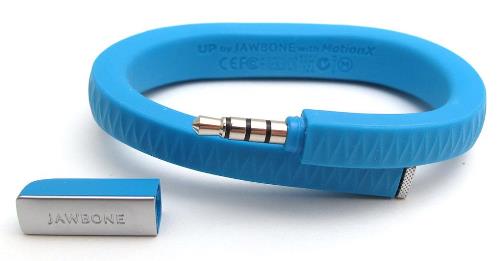
The Jawbone UP has been around for a while. It is not a Bluetooth device, you sync and charge it by removing a small cap and plugging it into a custom charger with a standard USB plug on one side and a special headphone jack on the other. To sync the Jawbone UP you plug it into the headphone jack of your smartphone. The UP works with iDevices and many, but not all, Android devices. Check the compatibility list before you buy this device, if you have an incompatible smartphone, you are completely out of luck. Jawbone cannot help you. Compatibility has to do with the way the phone's headphone jack functions, not the Jawbone UP band.
I like this band because I can wear it all the time. It's not waterproof, but it is very splash resistant so you can wear the band almost all the time. I usually charge it while I'm in the shower, but I've also been known to charge it while driving or sitting at my desk. It doesn't take very long to charge.
Pros:
Splash-resistant (very).
Light, fashionable, looks like a bracelet.
Can be worn all of the time.
Doesn't eat your phone battery.
Charge lasts for days.
Cons:
No Bluetooth and no display which means you need to plug it into your smartphone to get a status report.
Accuracy is average.
Lack of compatibility with certain popular Android devices.
Jawbone UP24 (List Price $149.95)
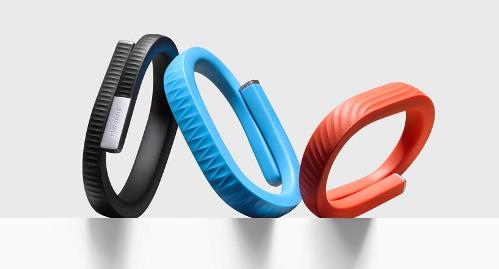
The latest and greatest wristband from Jawbone. Its Bluetooth comes in two colors and is supposed to be more accurate and more awesome than the original Jawbone UP. Sadly, the UP24 app for Android has not yet arrived, so for now, the UP25 is iDevice only.
Are you interested in syncing via Bluetooth? If so, this is your band. I don't think it's an important feature. In fact, when considering the other Bluetooth devices I need to sync to my smartphone, I think it's a huge pain – but that's just me. If you're an iPhone person and you've been dreaming of a Bluetooth UP, it's here.
Pros:
Splash-resistant.
Light, fashionable, looks like a bracelet.
Can be worn all of the time.
Charge lasts for days.
Bluetooth.
Cons:
No display which means you need to plug it into your smartphone to get a status report.
Accuracy is average.
Lack of compatibility with Android devices is an issue that should be solved soon.
Fitbit One ($99.95)
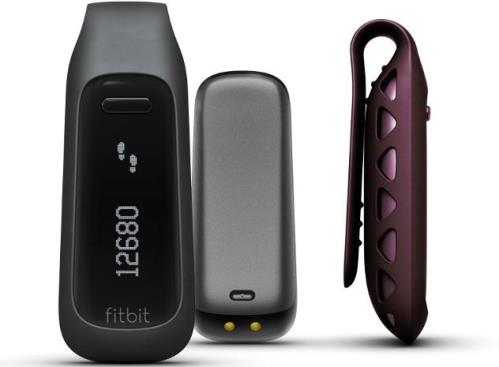
Fitbit has made a whole bunch of dongles and small fobs that can be placed in bracelets or worn using clips. The Fitbit One has a pseudo-display, but it is not splash or water resistant and I have put several Fitbit One's in my pocket, forgotten to take them out and washed them. Fitbits don't like to be placed in a washing machine.
I like the functionality of the Fitbit One, but the ergonomics don't work for me. I don't like the clip, I've explained my unhappiness with putting it in my pocket and wearing it on my wrist is aesthetically offensive to me. So, I'm not a fan. That said, female friends have told me that they clip it to their bra straps and get excellent results. I have no way to verify this, but I've been told several times by several different people.
Fitbit Flex ($99.95)
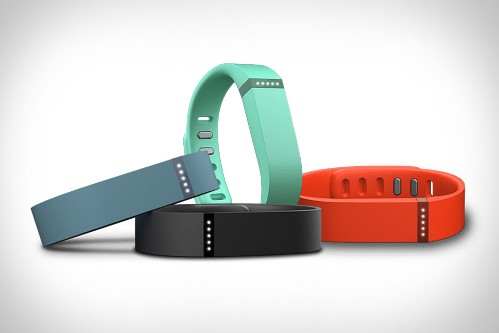
The Flex was Fitbit's answer to the Jawbone UP. It's awesome. Although it does not have a display, it has indicator lights that let you know how you're doing. Like all Fitbits, when you get within about 20 feet of the computer where you've plugged in the Fitbit USB dongle, the unit will sync with your computer and you can see the Fitbit dashboard which has a comprehensive readout of what the Fitbit has been measuring.
The Flex is water-resistant, so you can really get it wet. I like the Fitbit Flex a lot and recommend it as strongly as I recommend my Jawbone UP.
Pros:
Water-resistant.
Can be worn all of the time.
Charge lasts for days.
Good computer/web interface.
Cons:
Somewhat unattractive.
Accuracy is average.
Lack of compatibility with certain Android devices (be sure to check).
Fitbit Force ($129.95)
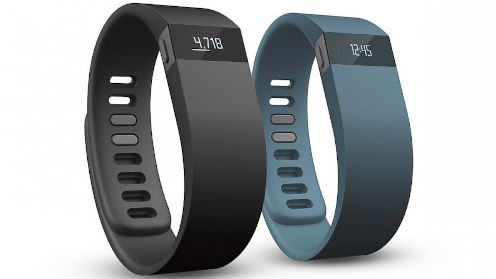
The Force is Fitbit's all-singing, all-dancing wristband. It has a display, Bluetooth 4.0, uber-compatibility, does everything every Fitbit device does and everything that every Jawbone device does.
One downside is that it is splash-resistant, not water-resistant. Although the device is marketed as water-resistant, the altimeter will malfunction if you submerge the unit – so don't submerge it! I can personally attest to this issue.
Secondly, some people have complained (some bitterly) about a curious rash that they believe is caused by the rubber bracelet. Fitbit has issued some refunds and says it is, "investigating the causes of the rashes."
Pros:
Complete Display
Water-resistant.
Can be worn all of the time.
Charge lasts for days.
Good computer/web interface.
Cons:
Curious rash reported (not by everyone, of course)
Big and obvious
Accuracy is average
The Bottom Line
You need to monitor your calories in, your calories out and your sleep. All of the devices by Jawbone and Fitbit will help you accomplish these goals. I'm partial to the original Jawbone UP because it is small, unobtrusive, and I don't have to think about it. That said, I like the Fitbit Force because when I'm really in the mood to watch what I'm doing, all of the info I want is right on my wrist. Depending on the day, this can be a huge plus.
In the end, what you buy will be more about your personality than the features and benefits of the wristband you choose. Like I said, they will all do the job... if you do yours. So, choose the wristband that you are most likely to use all the time. One you will only take off to charge or sync. Remember, no matter how pretty or interesting the device is, it is useless unless you use it 24/7.
Visit www.smartphonediet.info to learn more about how you can use your smartphone and a few relatively inexpensive devices to lose weight, feel great and stay fit forever. And, if you're really serious about living a healthier lifestyle, invest in a Fitbit, a Jawbone or any other monitoring device you can commit to use. It will really change your life.
Shelly Palmer is Fox 5 New York's On-air Tech Expert (WNYW-TV) and the host of Fox Television's monthly show Shelly Palmer Digital Living. He also hosts United Stations Radio Network's, Shelly Palmer Digital Living Daily, a daily syndicated radio report that features insightful commentary and a
Read all Shelly's MediaBizBloggers commentaries at Shelly Palmer Report.
Check us out on Facebook at MediaBizBloggers.com